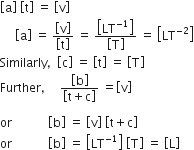The length, breadth and thickness of a block are given by l = 12 cm, b = 6 cm and t = 2.45 cm. The volume of the block according to the idea of significant figures should be
1 × 102 cm3
2 × 102 cm3
1.76 × 102 cm3
None of these
B.
2 × 102 cm3
Using relation for volume
Given:- length of a block = 12 cm
breadth of a block = 6 cm
thickness of a block = 2.45cm
V =length × breadth × thickness
=12 × 6 × 2.45 = 176.4
=1.764 ×102 cm3
The minimum number of significant figures is 1 in thickness, hence the volume will contain only one significant figure.
Therefore V= 2 ×102 cm3
The physical quantity of the dimensions of length that can be formed out of c, G and e/4πε0 is [c is the velocity of light, G is the universal constant of gravitation and e is charge]




A.

The velocity v of a particle at time t is given by  Â where a, b and c are constants, The dimensions of a, b and c are respectively:
 where a, b and c are constants, The dimensions of a, b and c are respectively:




A.

According to principle of homogeneity of dimensions, the dimensions of all the terms in a physical expression should be same.
  The given expression isÂ
            
From principle of homogeneity
   
Dimensions of resistance in an electrical circuit, in terms of the dimension of mass M, of length L, of time T and of current I, would be:
[ML2T-3I-1]
[ML2T-2]
[ML2T-1I-1]
[ML2T-1I-1]
D.
[ML2T-1I-1]
Resistance 
A student measured the diameter of a small steel ball using a screw gauge of least count 0.001 cm. The main scale reading is 5 mm and zero of circular scale division coincides with 25 divisions above the reference level. If screw gauge has a zero error of –0.004 cm, the correct diameter of the ball is
0.521 cm
0.525 cm
0.529 cm
0.053
C.
0.529 cm
Diameter of the ball
= MSR + CSR x (least count) - zero error
= 0.5 cm + 25 x 0.001 - (-0.004)
= 0.5 + 0.025 + 0.004
= 0.529 cm
